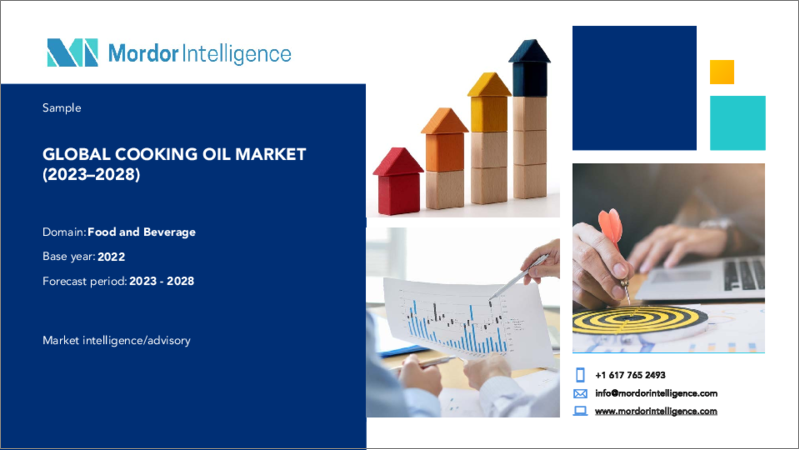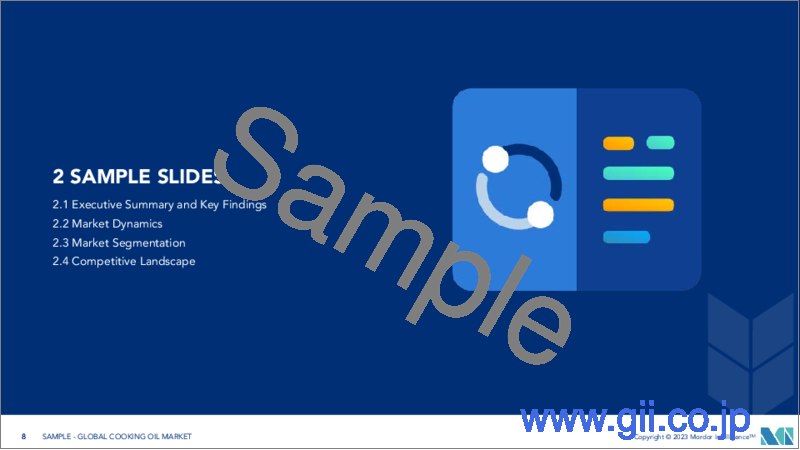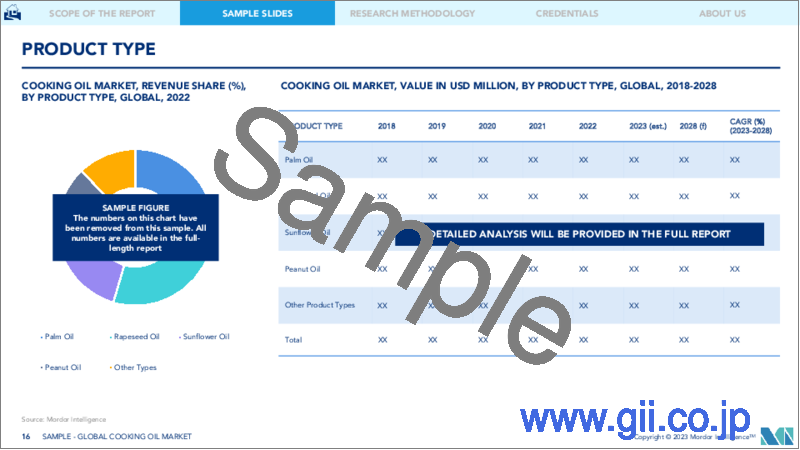|
|
市場調査レポート
商品コード
1190453
食用油の市場- 成長、動向、予測(2023年~2028年)Cooking Oil Market - Growth, Trends, and Forecasts (2023 - 2028) |
||||||
|
● お客様のご希望に応じて、既存データの加工や未掲載情報(例:国別セグメント)の追加などの対応が可能です。 詳細はお問い合わせください。 |
|||||||
| 食用油の市場- 成長、動向、予測(2023年~2028年) |
|
出版日: 2023年01月18日
発行: Mordor Intelligence
ページ情報: 英文 172 Pages
納期: 2~3営業日
|
- 全表示
- 概要
- 目次
食用油市場は、今後5年間にCAGR5.6%で成長すると予測されています。
世界のクッキングオイル市場は、健康志向の高い消費者による高品質な食用油/クッキングオイルの消費の増加や、キャンディーの製造を中心とした菓子類など様々な用途での需要拡大により、有機健康食品への需要が堅調に推移していることが要因として挙げられます。また、精製オリーブ油やココナッツオイルは、味が淡白で、食品本来の風味を保つことができるため、様々なベーカリー用途で使用されることが多くなっています。さらに、マスタードオイルのような辛味もありません。
非遺伝子組み換え食用油の需要も、ひまわり油、ココナッツオイル、オリーブオイルのシェアを拡大し、パーム油、キャノーラ油、大豆油などの研究市場の主要セグメントと一緒に、市場に仕出ししています。パーム油は、最も使用頻度の高い植物油の一つです。過去数年間、パーム油の生産量は大幅に増加し、そのほとんどをマレーシアとインドネシアで生産しています。しかし、森林伐採が環境に与える影響について消費者の認識が高まり、国際的なパームオイルフリー認証の取得が進んでいることから、パームオイルが様々な食品分野で使用されることが制限されています。
主な市場動向
パーム油が最も消費される油として浮上
パーム油は、世界で最も流通している食用油の一つです。パーム油の主な消費国は、中国、インド、インドネシア、EUなどです。これらの国では粗パーム油の生産が行われていないため、その需要はすべて輸入でまかなわれています。パーム油は、他の食用油に比べて価格が2割ほど安いため、世界中の様々なエンドユーザーから大きな需要があります。ここ数年、パーム油の生産と輸入は大幅に増加し、マレーシアとインドネシアでほぼ全量を賄っています。
米国農務省によると、今年度のパーム油の輸入量は4756万トンで、前年度の4721万トンを上回っています。さらに、ほとんどの先進国でバイオ燃料の需要が増加しています。このことが、パーム油の需要を高めています。その他の主な需要な要因としては、パーム油が食品業界の様々な場面で多用途に使用されていることが挙げられます。
アジア太平洋地域が市場で重要なシェアを占める
アジア太平洋地域は、世界の植物油市場の最大のシェアを占めており、2番目に急成長している地域です。アジア太平洋地域は、中国、インド、ベトナム、インドネシアに養殖業が集中しているため、魚油の消費において支配的な市場として浮上しています。さらに、消費者の間で高まる健康への関心が、日本やオーストラリアなどの先進国での栄養補助食品としての魚油の使用につながります。特にオリーブオイルは、その健康上の利点から、最も高い成長率を示しています。
アジア太平洋地域では、中国が植物油の消費量および生産量において最大のシェアを占めています。生産量は多いもの、消費量が生産量を上回っているため、輸出量に比べ輸入量が多くなっています。中国は輸入志向の強い国です。健康志向の消費者の増加、強固な人口基盤、生活水準の変化に加え、この地域に主要なパーム油生産国があることから、食品産業からの需要が非常に大きいことが理由です。また、食用油の使用量が増加している要因として、加工食品の消費量が増加していることが挙げられます。
競合情勢
世界の食用油市場は断片的でありながら競争が激しく、Archer Daniels Midland Company、Bunge Limited、不二製油グループ、Cargill Incorporated、Olam Oil Groupなどの大手企業が大きなシェアを占めています。市場のこれらの主要企業は、適切な消費者に適切な製品を提供することを目指しています。製品の品質、種類、用途、その他の属性における一貫した革新は、市場で強力な足場を維持するために必要不可欠です。さらに、成熟した市場であるため、石油メーカーは既存の市場に深く浸透するために、買収や拡張など他の戦略にも重点を置いています。
その他の特典
- エクセル形式の市場予測(ME)シート
- アナリストによる3ヶ月間のサポート
目次
第1章 イントロダクション
- 調査の前提条件と市場の定義
- 調査対象範囲
第2章 調査手法
第3章 エグゼクティブサマリー
第4章 市場力学
- 市場促進要因
- 市場抑制要因
- ポーターのファイブフォース分析
- 新規参入業者の脅威
- 買い手/消費者の交渉力
- 供給企業の交渉力
- 代替品の脅威
- 競争企業間の敵対関係
第5章 市場セグメンテーション
- 製品タイプ別
- パーム油
- 菜種油
- ひまわり油
- ピーナッツオイル
- その他のタイプ
- 用途別
- ベーカリー・菓子類
- スナック菓子
- サラダ、調理用油脂
- マーガリン、フィリング、スプレッド
- その他の用途
- 地域別情報
- 北米
- 米国
- カナダ
- メキシコ
- その他北米地域
- 欧州
- 英国
- ドイツ
- スペイン
- フランス
- イタリア
- ロシア
- その他の欧州地域
- アジア太平洋地域
- 中国
- 日本
- インド
- オーストラリア
- その他アジア太平洋地域
- 南米
- ブラジル
- アルゼンチン
- その他の南米地域
- 中東・アフリカ地域
- サウジアラビア
- サウジアラビア
- その他中東地域
- 北米
第6章 競合情勢
- リーディングプレーヤーが採用する戦略
- 市場シェア分析
- 企業プロファイル
- Archer Daniels Midland Company
- Cargill Incorporated
- Bunge Limited
- Olam International Limited
- Fuji Oil Group
- Wilmar International Limited
- Alami Commodities Sdn Bhd
- Musim Mas Group
- Richardson International
- J Oil Mills Inc.
第7章 市場機会と将来動向
The cooking oil market is projected to register a CAGR of 5.6% during the next five years.
The global cooking oil market is driven by the robust demand for organic health-based products, with increased consumption of high-quality edible oils/cooking oils by health-conscious consumers and the growing demand from various applications, such as confectionery, primarily in the production of candies. Also, refined olive oil and coconut oil are increasingly used in various bakery applications, as they are bland in taste, allowing the food to maintain its original flavor. Additionally, they do not exhibit any pungency, unlike mustard oil.
The demand for non-GMO edible oil has also catered to the market, as it augmented the shares of sunflower oil, coconut oil, and olive oil, together with leading segments of the market studied, including palm oil, canola oil, and soybean oil. Palm oil is one of the most highly used vegetable oils. In the past few years, palm oil production amplified significantly, with almost all production growth set in Malaysia and Indonesia. However, the associated large-scale deforestation is restricting palm oil's application in varied food sectors, as consumers are becoming highly aware of the damages caused by deforestation to the environment, and they are opting for the International Palm Oil Free Certification.
Key Market Trends
Palm Oil Emerges as the Most Consumed Oil
Palm oil is one of the most distributed cooking oils in the world. The primary users of palm oil include China, India, Indonesia, and the European Union. These countries do not produce crude palm oil, and their demand is entirely met by imports. There is substantial demand for palm oil from various end-user sectors across the world since it costs 20% less than most cooking oils. In the past few years, the production and imports of palm oil amplified significantly, with almost the entire demand supplied by Malaysia and Indonesia.
According to the US Department of Agriculture, palm oil imports were 47.56 million metric tons during the current year, which was higher than the previous year's imports which were 47.21 million metric tons. Furthermore, there has been an increase in the demand for biofuel in most developed regions. This, in turn, is augmenting the demand for palm oil. Other chief demand drivers include the versatility and extensive application of palm oil in various aspects of the food industry.
Asia-Pacific Holds Significant Share in the Market
Asia-Pacific accounts for the largest share of the global vegetable oil market, and it is the second-fastest-growing region. Asia-Pacific has emerged as a dominant market for fish oil consumption owing to the massive concentration of the aquaculture industry in China, India, Vietnam, and Indonesia. Moreover, the rising health concerns among consumers lead to the usage of fish oil as a nutritional supplement in developed countries such as Japan and Australia. Olive oil, in particular, has the highest growth rate due to its health benefits.
In Asia-Pacific, China holds the largest share of vegetable oil consumption as well as production. Though the production volume is high, consumption exceeds production, resulting in higher import volumes when compared to export volumes. China is an import-oriented country. Due to the huge demand from food industries, attributed to the increasing number of health-conscious consumers, strong population base, and changing living standards, coupled with the presence of major palm oil-producing nations in the region. Additionally, a prominent factor in the increasing edible oil use is the growing consumption of processed food.
Competitive Landscape
The global cooking oil market is fragmented yet competitive, with a significant share held by leading players, such as Archer Daniels Midland Company, Bunge Limited, Fuji Oil Group, Cargill Incorporated, and Olam Oil Group. These key players in the market aim to target the right product to the right consumer. Consistent innovation in product quality, variety, usage, and other attributes is essential to maintaining a strong foothold in the market. Additionally, as it is a mature market, the oil manufacturers focus on other strategies, such as acquisitions and expansions, in order to penetrate deeper into the pre-existing markets.
Additional Benefits:
- The market estimate (ME) sheet in Excel format
- 3 months of analyst support
TABLE OF CONTENTS
1 INTRODUCTION
- 1.1 Study Assumptions and Market Definition
- 1.2 Scope of the Study
2 RESEARCH METHODOLOGY
3 EXECUTIVE SUMMARY
4 MARKET DYNAMICS
- 4.1 Market Drivers
- 4.2 Market Restraints
- 4.3 Porter's Five Forces Analysis
- 4.3.1 Threat of New Entrants
- 4.3.2 Bargaining Power of Buyers/Consumers
- 4.3.3 Bargaining Power of Suppliers
- 4.3.4 Threat of Substitute Products
- 4.3.5 Intensity of Competitive Rivalry
5 MARKET SEGMENTATION
- 5.1 By Product Type
- 5.1.1 Palm Oil
- 5.1.2 Rapeseed Oil
- 5.1.3 Sunflower Oil
- 5.1.4 Peanut Oil
- 5.1.5 Other Types
- 5.2 By Application
- 5.2.1 Bakery and Confectionery
- 5.2.2 Snack Foods
- 5.2.3 Salads and Cooking Oils
- 5.2.4 Margarine, Fillings, and Spreads
- 5.2.5 Other Applications
- 5.3 By Geography
- 5.3.1 North America
- 5.3.1.1 United States
- 5.3.1.2 Canada
- 5.3.1.3 Mexico
- 5.3.1.4 Rest of North America
- 5.3.2 Europe
- 5.3.2.1 United Kingdom
- 5.3.2.2 Germany
- 5.3.2.3 Spain
- 5.3.2.4 France
- 5.3.2.5 Italy
- 5.3.2.6 Russia
- 5.3.2.7 Rest of Europe
- 5.3.3 Asia-Pacific
- 5.3.3.1 China
- 5.3.3.2 Japan
- 5.3.3.3 India
- 5.3.3.4 Australia
- 5.3.3.5 Rest of Asia-Pacific
- 5.3.4 South America
- 5.3.4.1 Brazil
- 5.3.4.2 Argentina
- 5.3.4.3 Rest of South America
- 5.3.5 Middle East and Africa
- 5.3.5.1 Saudi Africa
- 5.3.5.2 Saudi Arabia
- 5.3.5.3 Rest of Middle East and Africa
- 5.3.1 North America
6 COMPETITIVE LANDSCAPE
- 6.1 Strategies Adopted by Leading Players
- 6.2 Market Share Analysis
- 6.3 Company Profiles
- 6.3.1 Archer Daniels Midland Company
- 6.3.2 Cargill Incorporated
- 6.3.3 Bunge Limited
- 6.3.4 Olam International Limited
- 6.3.5 Fuji Oil Group
- 6.3.6 Wilmar International Limited
- 6.3.7 Alami Commodities Sdn Bhd
- 6.3.8 Musim Mas Group
- 6.3.9 Richardson International
- 6.3.10 J Oil Mills Inc.




